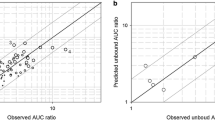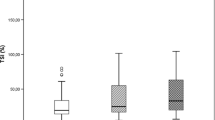Summary
Apparent pharmacokinetic parameters of caffeine elimination from the circulation were determined in 27 patients with histologically confirmed liver cirrhosis, 8 patients with miscellaneous liver disease, and 8 patients with other than liver disease. The usefullness of this quantitative test to assess the severity of liver cirrhosis was compared to the Child-Turcotte or Child-Pugh classification score as well as to the galactose elimination capacity of these patients. Using reversed-phase high pressure liquid chromatography caffeine, paraxanthine, theophylline, and theobromine were analysed in blood plasma collected before and after an oral dose of caffeine. Compared to apparent caffeine pharmacokinetics in patients with normal livers or miscellaneous liver disease, cirrhosis was characterized by a statistically significant reduction in apparent caffeine clearance and prolongation in half-life. The reduced apparent plasma disappearance rate of caffeine in cirrhotics was related to the retarded formation of paraxanthine which was the main metabolite of caffeine in blood plasma both in the absence or presence of liver disease. The apparent caffeine clearance in cirrhosis decreased with increasing Child-Turcotte classification score: Child's class A patients differed significantly from Child's class B or Child's class C patients, whereas the difference between Child's class B and C patients did not reach statistical significance (Wilcoxon's rank test). In addition there was a strong correlation between the Child-Pugh classification score and apparent caffeine clearance (P<0.001). However, no correlation existed between Child's classification and galactose elimination capacity. Our data emphasize the value of the Child-Turcotte or Child-Pugh classification in assessing the severity of liver cirrhosis in a simpler and less time-consuming way than using quantitative liver function tests.
Similar content being viewed by others
Abbreviations
- AUC:
-
Area under curve
- Cl:
-
apparent caffeine clearance
- GEC:
-
galactose elimination capacity
- V0 :
-
distribution volume
References
Abbott PJ (1986) Caffeine: a toxicological overview. Med J Aust 145:518–521
Barbare JC, Poupon RE, Jaillon P, Prod'homme S, Darnis F, Poupon RY (1985) Intrinsic hepatic clearance and Child-Turcotte classification for assessment of liver function in cirrhosis. J Hepatol 1:253–259
Bircher J (1986) Assessment of prognosis in advanced liver disease: to score or to measure, that's the question. Hepatology 6:1036–1037
Bircher J, Blankart R, Halpern A, Häcki W, Laissue J, Preisig R (1973) Criteria for assessment of functional impairment in patients with cirrhosis of the liver. Eur J Clin Invest 3:72–85
Blanchard J, Sawers SJA (1983) The absolute bioavailability of caffeine in man. Eur J Clin Pharmacol 24:93–98
Bonati M, Latini R, Galletti F, Young JF, Tognoni G, Garattini S (1982) Caffeine disposition after oral doses. Clin Pharmacol Ther 32:98–106
Broughton LJ, Rogers HJ (1981) Decreased systemic clearance of caffeine due to cimetidine. Br J Clin Pharmac 12:155–159
Caesar U (1983) Koffein bei Lebererkrankungen. Thesis, Würzburg
Child CG, Turcotte JG (1964) Surgery and portal hypertension. In: Child CG (ed) The liver and portal hypertension. WB Saunders, Philadelphia, pp 50–62
Christensen E, Schlichting P, Fauerholdt L, Gluud C, Andersen PK, Juhl E, Poulsen H, Tygstrup N (1984) Prognostic value of Child-Turcotte criteria in medically treated cirrhosis. Hepatology 4:430–435
Christensen E, Schlichting P, Kragh Anderson P, Fauerholdt L, Schou G, Vestergaard Pedersen B, Juhl E, Poulsen H, Tygstrup N, The Copenhagen Study Group for Liver Diseases (1986) Updating prognosis and therapeutic effect evaluation in cirrhosis with Cox's multiple regression model for time-dependent variables. Scand J Gastroenterol 21:163–174
Conn HO (1981) A peek at the Child-Turcotte classification. Hepatology 1:673–676
Desmond PV, Patwardhan RV, Johnson RF, Schenker S (1980) Impaired elimination of caffeine in cirrhosis. Dig Dis Sci 25:193–197
Infante-Rivard C, Esnaola S, Villeneuve J-P (1987) Clinical and statistical validity of conventional prognostic factors in predicting short-term survival among cirrhotics. Hepatology 7:660–664
Jenne JW, Chick TW, Miller BA, Dee Strickland R (1974) Effect of congestive heart failure on the elimination of theophylline (Abstract). J Allergy Clin Immunol 53:80
Jost G, Wahlländer A, Von Mandach U, Preisig R (1987) Overnight salivary caffeine clearance: a liver function test suitable for routine use. Hepatology 7:338–344
Kalow W (1985) Variability of caffeine metabolism in humans. Drug Res 35:319–324
Kamimori GH, Somani SM, Knowlton RG, Perkins RM (1987) The effects of obesity and exercise on the pharmacokinetics of caffeine in lean and obese volunteers. Eur J Clin Pharmacol 31:595–600
Kotake AN, Schoeller DA, Lambert GH, Baker AL, Schaffer DD, Josephs H (1982) The caffeine CO2 breath test: dose response and route ofN-demethylation in smokers and nonsmokers. Clin Pharmacol Ther 32:261–269
Lambert GH, Schoeller DA, Kotake AN, Flores C, Hay D (1986) The effect of age, gender, and sexual maturation on the caffeine breath test. Dev Pharmacol Ther 9:375–388
Lelo A, Miners JO, Robson R, Birkett DJ (1986) Assessment of caffeine exposure: caffeine content of beverages, caffeine intake, and plasma concentrations of methylxanthines. Clin Pharmacol Ther 39:54–59
Lelo A, Birkett DJ, Robson RA, Miners JO (1986) Comparative pharmacokinetics of caffeine and its primary demethylated metabolites paraxanthine, theobromine and theophylline in man. Br J Clin Pharmacol 22:177–182
Lelo A, Miners JO, Robson RA, Birkett DJ (1986) Quantitative assessment of caffeine partial clearances in man. Br J Clin Pharmacol 22:183–186
Mangione A, Imhoff TE, Lee RV, Shum LY, Jusko WJ (1978) Pharmacokinetics of theophylline in hepatic disease. Chest 73:616–622
McLean AEM (1975) The measurement of liver injury and protection, with special reference to paracetamol, dimethylnitrosamine and carbon tetrachloride. In: Keppler D (ed) Pathogenesis and mechanisms of liver cell necrosis. MTP Press, Lancaster, pp 119–127
Onrot J, Shaheen O, Biaggioni I, Goldberg MR, Feely J, Milkinson GR, Hollister AS, Robertson D (1986) Reduction of liver plasma flow by caffeine and theophylline. Clin Pharmacol Ther 40:506–510
Orrego H, Israel Y, Blake JE, Medline A (1983) Assessment of prognostic factors in alcoholic liver disease: toward a global quantitative expression of severity. Hepatology 3:896–905
Parsons WD, Neims AH (1978) Effect of smoking on caffeine clearance. Clin Pharmacol Ther 24:40–45
Pathwardhan RV, Desmond PV, Johnson RF, Schenker S (1980) Impaired elimination of caffeine by oral contraceptive steroids. J Lab Clin Med 95:603–608
Piafsky KM, Sitar SD, Rangno RE, Ogilvie RJ (1977) Theophylline kinetics in acute pulmonary edema. Clin Pharmacol Ther 21:310–316
Preisig R (1985) Fremdsubstanzen als Indikatoren der Leberfunktion. Schweiz Med Wochenschr [Suppl 19] 115:36–42
Pugh RNH, Murray-Lyon IM, Dawson JL, Pietroni MC, Williams R (1973) Transection of the oesophagus for bleeding oesophageal varices. Br J Surg 60:646–649
Reichen J, Le M (1986) Verapamil favorably influences hepatic microvascular exchange and function in rats with cirrhosis of the liver. J Clin Invest 78:448–455
Renner E, Wahlländer A, Huguenin P, Wietholz H, Preisig R (1983) Coffein — ein ubiquitärer Indikator der Leberfunktion. Schweiz Med Wochenschr 113:1074–1081
Renner E, Wietholz H, Huguenin P, Arnaud MJ, Preisig R (1984) Caffeine: a model compound for measuring liver function. Hepatology 4:38–46
Ritschel WA, Hussain AS, Wetzelsberger N, Lücker PW (1985) Theophylline-ranitidine drug interaction in the beagle dog. Methods Find Exp Clin Pharmacol 7:631–636
Statland BE, Demas TJ (1980) Serum caffeine half-lives. Healthy subjects vs patients having alcoholic hepatic disease. Am J Clin Pathol 73:390–393
Stavric B, Klassen R (1984) Automated high-performance liquid chromatographic assay for monitoring caffeine and its meabolites in biological fluids of monkeys consuming caffeine. J Chromatogr 310:107–118
Tang-Liu DD, Williams RL, Riegelman S (1983) Disposition of caffeine and its metabolites in man. J Pharm Exp Ther 224:180–185
Tygstrup N (1966) Determination of hepatic elimination of galactose by single injection. Scand J Clin Lab Invest [Suppl 92] 18:118–125
Villeneuve J-P, Infante-Rivard C, Ampelas M, Pomier-Layrargues G, Muet P-M, Marleau DT (1986) Prognostic value of the aminopyrine breath test in cirrhotic patients. Hepatology 6:928–931
Wahlländer A, Renner E, Preisig R (1985) Fasting plasma caffeine concentration. A guide to the severity of chronic liver disease. Scand J Gastroenterol 20:1133–1141
Wang T, Kleber G, Stellaard F, Paumgartner G (1985) Caffeine elimination: a test of liver function. Klin Wochenschr 63:1124–1128
Wietholz H, Voegelin M, Arnaud MJ, Bircher J, Preisig R (1981) Assessment of the cytochrome P-448 dependent liver enzyme system by a caffeine breath test. Eur J Clin Pharmacol 21:53–59
Zilly W, Caesar U, Staib AH, Heusler H, Richter E (1982) Die Elimination von Koeffein bei Lebererkrankungen. In: Rietbrock N, Woodcock BG, Staib AH (eds) Theophylline and other methylxanthines. Vieweg, Braunschweig, pp 69–75
Zilly W, Ziegler M, Richter E (1986) Interaktion zwischen Coffein and Theophyllin. Med Klin 81:560–562
Author information
Authors and Affiliations
Additional information
Dedicated to Prof. G.-W. Löhr on the occasion of his 65th birthday
Supported by SFB 154 “Klinische und experimentelle Hepatologie”
Rights and permissions
About this article
Cite this article
Holstege, A., Staiger, M., Haag, K. et al. Correlation of caffeine elimination and child's classification in liver cirrhosis. Klin Wochenschr 67, 6–15 (1989). https://doi.org/10.1007/BF01736528
Received:
Revised:
Accepted:
Issue Date:
DOI: https://doi.org/10.1007/BF01736528




